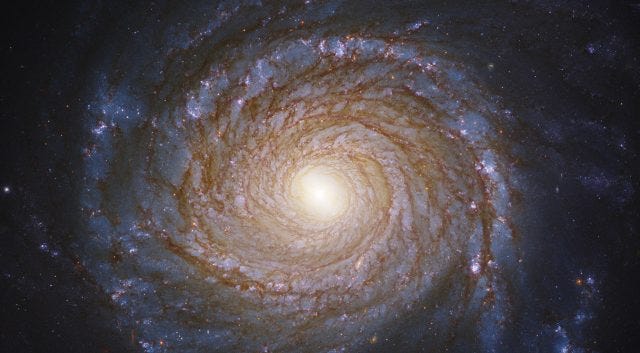Unraveling the Mystery of a Black Hole That Defies Expectations
Written on
Chapter 1: The Enigma of NGC 3147
Recent observations from the Hubble Space Telescope have unveiled a black hole that seemingly contradicts established scientific principles. Traditionally, it is understood that supermassive black holes reside at the centers of most large galaxies, and only “active” galaxies exhibit visible accretion discs. However, Hubble has identified an accretion disc around a black hole that possesses an unexpectedly low luminosity. This revelation not only challenges preconceived notions but also presents a unique opportunity to explore the practical applications of relativity.
NGC 3147, a spiral galaxy that is slightly smaller than our Milky Way, is located approximately 120 million light-years away. Its striking visuals have likely caught your eye in various astronomical images. Active galaxies, such as quasars, are easily recognizable due to the emissions created by matter falling into their centers, which are visible across the electromagnetic spectrum. Until recently, NGC 3147 was believed to be too faint to possess its own accretion disc. However, new analyses conducted by an international team have overturned this belief.
Hubble's observations revealed that the central black hole in NGC 3147 has a mass roughly 250 million times that of our sun. Surprisingly, it hosts a thin disc of material akin to those found around more active galactic nuclei. Hubble’s data indicate that this disc spins at about 10% of the speed of light. Researcher Stefano Bianchi from the Università degli Studi Roma Tre in Italy states that this finding suggests existing models for low luminosity galaxies are fundamentally flawed.

The implications of this discovery extend far beyond mere curiosity; it could significantly reshape our understanding of galaxy formation and the physics governing supermassive black holes. The combination of the swiftly rotating disc and the faint brightness of NGC 3147 may facilitate testing of both general and special relativity. General relativity explores the nature of gravity within the universe, while special relativity examines the interplay between space and time. Given NGC 3147's dimmer profile compared to typical active galaxies, the accretion disc is more discernible, allowing scientists to investigate its interactions with light in the context of the black hole's intense gravitational field.
The findings related to NGC 3147 may prompt astronomers to seek out additional weakly active galaxies, potentially even those nearer to Earth, which would enable more precise measurements to validate Einstein’s theories.
The first video titled "It Shouldn't Exist! JWST Finds a Strange Black Hole at the Edge of Time" delves into how the James Webb Space Telescope has observed a peculiar black hole, challenging our understanding of cosmic phenomena.
Now read: Cold Quasars Could Change Our Understanding of Galactic Death, Astronomers Capture Historic First Photo of a Black Hole, Researchers Use Supersonic Fluid to Test Hawking's Black Hole Theories.
Chapter 2: New Avenues of Research
The second video titled "Hubble Catches Possible Runaway Black Hole" discusses Hubble's latest findings that may indicate the existence of a black hole on the move, providing further insight into the dynamic nature of these mysterious cosmic entities.